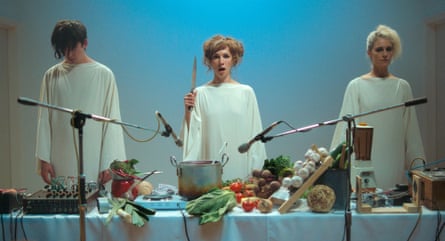A
An age-old saying in Hollywood cautions inexperienced directors against involving children, animals, and water in their productions. It would be wise to add food to this list as well, as it can be just as challenging to work with during the filmmaking process.
It is possible to enhance the appearance of a roast chicken by using hairspray to achieve a perfectly basted shine, or by blowing cigarette smoke over it to mimic steam from the oven. However, to accurately depict the process of cooking, as Trần Anh Hùng does in his award-winning film The Taste of Things, requires careful planning, patience, and improvisation. In the film’s impressive opening scene, private chef Eugénie (played by Juliette Binoche) expertly prepares a multi-course meal for her employer, renowned restaurateur Dodin Bouffant (played by Benoît Magimel). As she broils fish and pan-sears lettuce hearts, Hùng’s camera smoothly follows her every move with confidence, hiding all the meticulous effort behind her actions.
Ingredients don’t follow instructions like actors do, they only have one chance to be cooked perfectly before they become soggy or burnt. In an interview with Filmmaker Magazine, Hùng shared that Eugénie and Dodin had been working together for almost 20 years, which created a feeling of harmony in their work. Hùng wanted to convey this harmony to the audience, which is why he used a complex camera movement combined with the movement of the chefs in the kitchen, creating a ballet-like sequence to express the idea of harmony. This visually stunning sequence, much like the meal being prepared, showcases the skilled and passionate work of an artisan.
Films about food, including its physical characteristics, history, and philosophy, offer a sense of comfort similar to the food itself. The tangible nature of food portrayed on screen can evoke strong reactions from viewers. For example, a McDonald’s commercial can trigger a desire for a burger through the visual of juicy meat and fresh vegetables. Hùng’s romantic story also captures the deeper meaning behind food, beyond just satisfying hunger. It highlights the idea that a dish can nourish not only the body but also the soul. This is all tied to the preparation of the food, which goes beyond technique and is driven by intention. While it may be a cliche, true food lovers understand that the secret ingredient is love.
Regarding advertisements for fast food, they have recently adopted elements from ASMR videos found online, utilizing extreme close-ups and high-quality sound effects to market the product instead of traditional narration. The sounds of crunching, sizzling, and sloshing elicit a sensory response on a subconscious level, a concept explored in Peter Strickland’s 2022 film, Flux Gourmet. At the Sonic Catering Institute, experimental musicians use modular synthesizers and food to create avant-garde music, blending instinctual and conceptual elements in their creative process. Through their messy and unconventional art, they can express their ego, vulnerability, jealousy, confession, or flirtation, with the underlying intention of conveying meaning. By infusing food with deeper significance, it becomes more than just sustenance.
Movies have traditionally viewed the deep personal connection involved in cooking for others as a natural part of life, with a focus on tender, affectionate forms of closeness. The act of preparing a meal from scratch, with its attention to detail and dedication, inherently suggests a commitment to nourishing another person. On the other hand, cooking for oneself can feel incredibly lonely and depressing, as it highlights one’s solitude and the lack of someone worthy to share their efforts with. In the film Bridesmaids, Kristen Wiig’s character, a lonely and unlucky-in-love individual, spends all night creating a perfect cupcake adorned with hand-piped flower designs, only to sadly eat it alone in her kitchen. Similarly, movies often depict eating in a detached and impersonal way as a sign of despair, with characters at their lowest point resorting to frozen microwave meals or fast food. (In Lego Batman, the titular character contemplates his empty existence while nuking a lobster thermidor for two minutes. As always, the humor lies in its relatable truth.)

Unable to reword.
All stories about food are also stories about love, whether it’s a romantic relationship (like in the ramen-fueled drama Tampopo), a sibling bond (like in the lively restaurant comedy Big Night), or a person’s self-discovery (like in the foodie travelogue Eat Pray Love). In many romantic comedies, the characters show their growing intimacy by cooking and spending the night together, such as in the clever spoof They Came Together where they even taste tomato sauce together. Even in the most poorly executed examples, there is still a genuine emotional connection through small acts of kindness, highlighting the beauty of selfless devotion in everyday terms. The 2008 film The Ramen Girl, where the people of Japan help Brittany Murphy get over a breakup by teaching her how to make noodles, wholeheartedly believes in the special bond between a chef and their diner, despite its overly peppy and stereotypical portrayal of “oriental” culture.
The main focus of The Taste of Things is the romantic relationship between Eugénie and Dodin, which is expressed through their shared love of cooking. The passion they have for each other is reflected in the indulgent French cuisine they create together. Each dish they prepare is like a love letter, filled with care and thoughtfulness. Instead of relying on music to express their feelings, they use the hearty beef stew known as pot-au-feu to convey their emotions. Cooking becomes a symbol for their commitment to each other, with every meal representing a small act of devotion.
Source: theguardian.com


